The arrival of rainy season in Laos fell on deaf ears.
“It sure seems to be raining a lot lately,” Sheena would say. “That’s just orographic precipitation and the rain shadow effect, my dear Sheena,” I would confidently retort. My lady can be so silly. We woke up and started driving south, the rain continued to fall, and it seemed it would never stop. Without any warning, the mud on the side of a particularly steep mountainside got very saturated, and then became free from friction’s evil grip and covered the road—our road. We came around a bend to find a long line of cars just sitting there. I asked Nacho to stop and I walked all the way to the front of the cars to see what in God’s name was going on. And then I saw the rocks and mud and very mature trees all sprawled out across the narrow mountain roadway and I realized what had happened. It was a dang landslide, and it made even me start to question everything I ever learned about orographic precipitation and the rain shadow effect.
Brad and Sheena are driving around the world in “Nacho”, their Volkswagen Vanagon. Read their stories and follow their adventure at Drive Nacho Drive [link]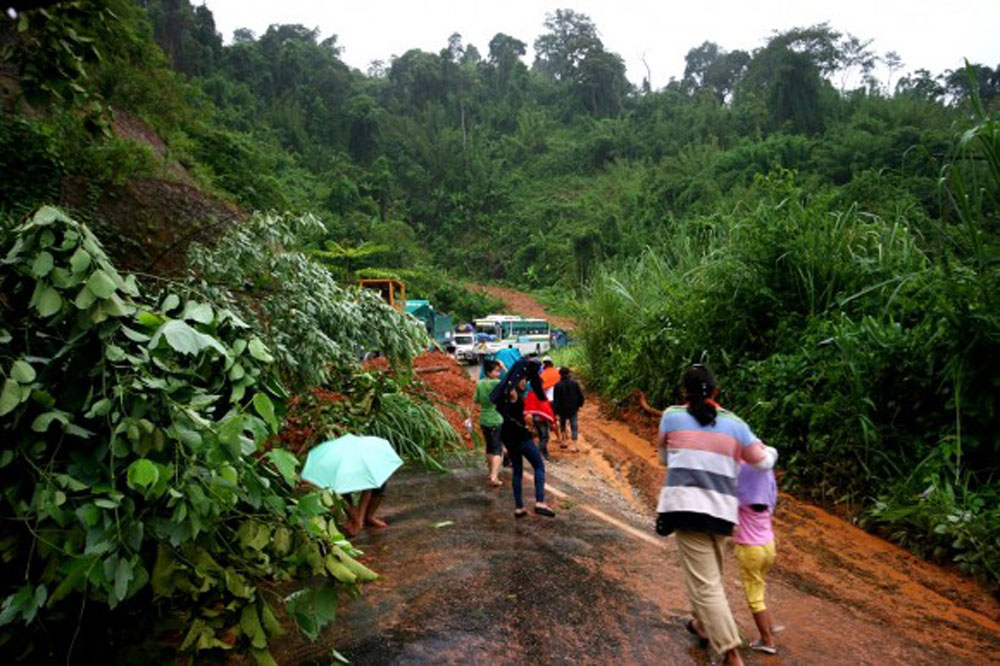
Initially I stood there like a wide-eyed schoolboy, sheltered from the driving rain by my purple umbrella, staring with amazement at the enormity of the mud and detritus strewn all over the place, and then at the naked hillside devoid of trees and much of its prior landmass. And then the mud. And then the hillside. Wow! I eventually walked back to the van and told Sheena.
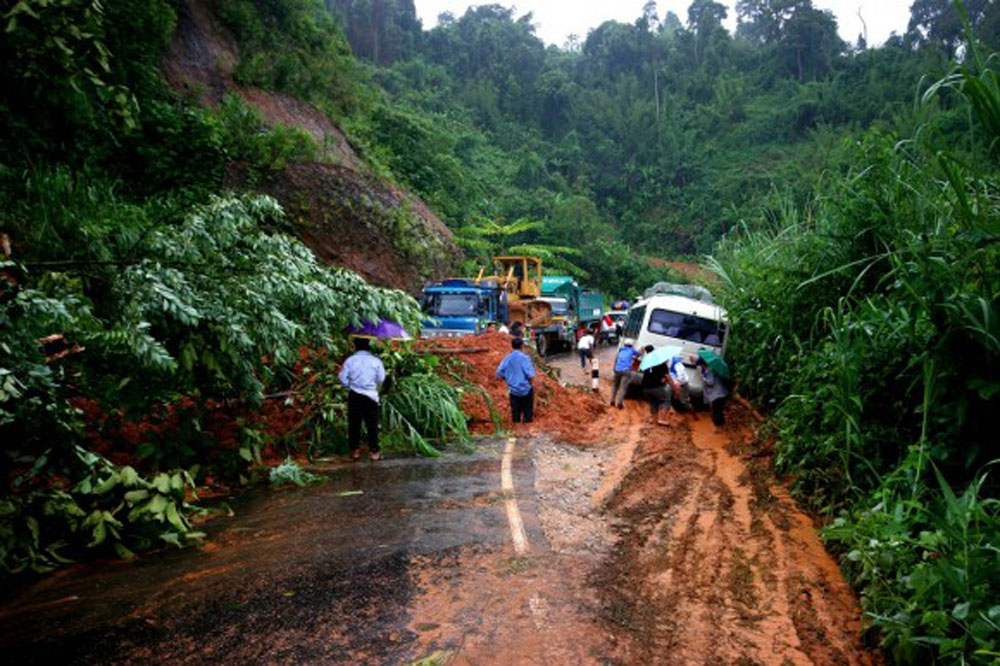
“Wow! There was a hillside with nothing on it, and there was also a thick layer of mud and detritus!” She was just going to have to see for herself, for I was too excited to give a non-cryptic description.
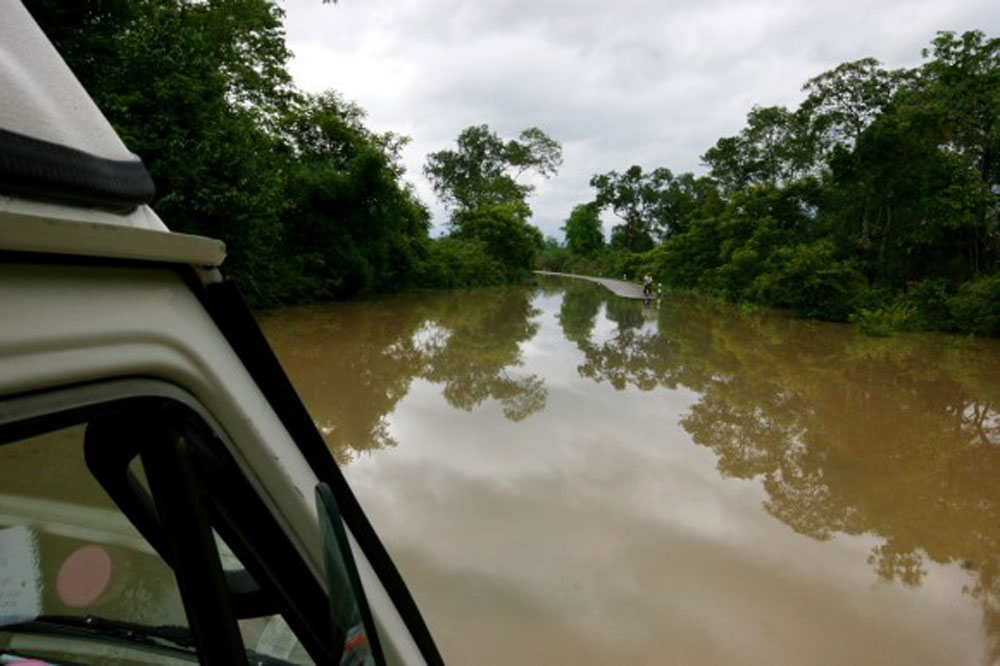
We speed walked together back to the scene, she with her orange Snoopy umbrella and me with my purple one, and watched the scene unfold. The folks on the near side of the slide stood around in the rain, looking at the mud. The folks on the far side looked on in a similar fashion. Ironically, the first vehicle to arrive on the far side was a semi truck carrying a very large bulldozer, but I rationalized that there was something wrong with the bulldozer that would prohibit it from clearing the slide. I came to this conclusion after the bulldozer failed to make any attempt at clearing the slide. After much nervous chatter, some brave people had ideas.
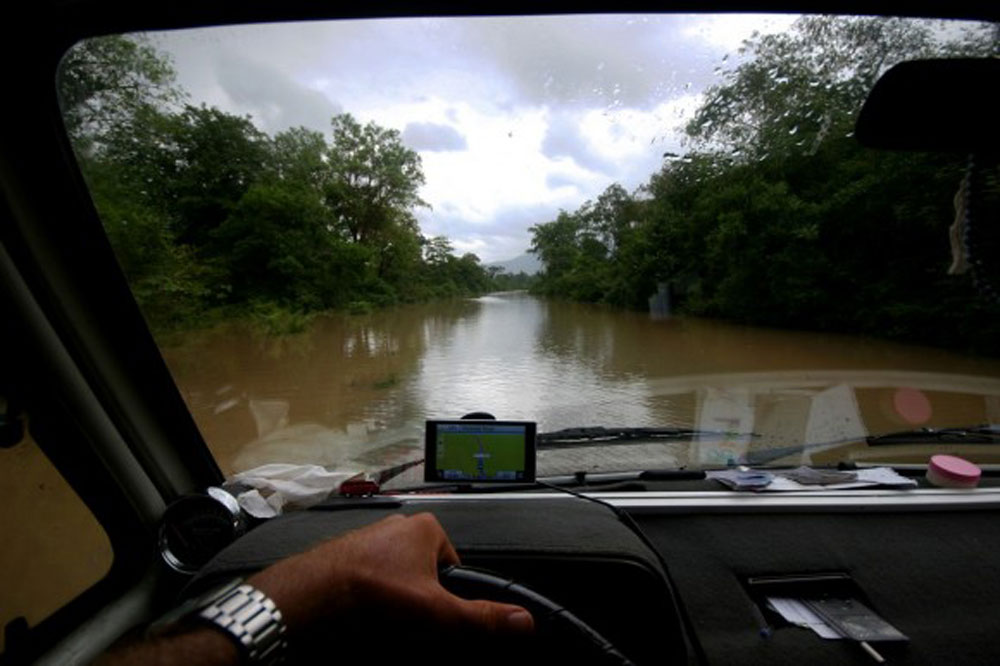
First, a man with a 4×4 Toyota Hilux fired up his truck and timidly approached the slide. He steered off the road, toward the thick vegetation separating the road from the bottomless abyss of the deep canyon below. He gunned it, slid all over the place, spun his tires, flung mud, and just by the skin of his teeth managed to get his truck back onto the road before either rolling or sliding off into oblivion. The confidence of the people had been aroused, and a few other Hilux owners followed suit. The Hilux is a popular truck in these parts. Soon, a crazy bastard in a two wheel drive sedan tried and succeeded. I stood there for many minutes studying the best lines, noting the obstacles hidden by the deep river that had formed in the right tire track, and visualizing Nacho’s triumph over this seemingly insurmountable challenge.

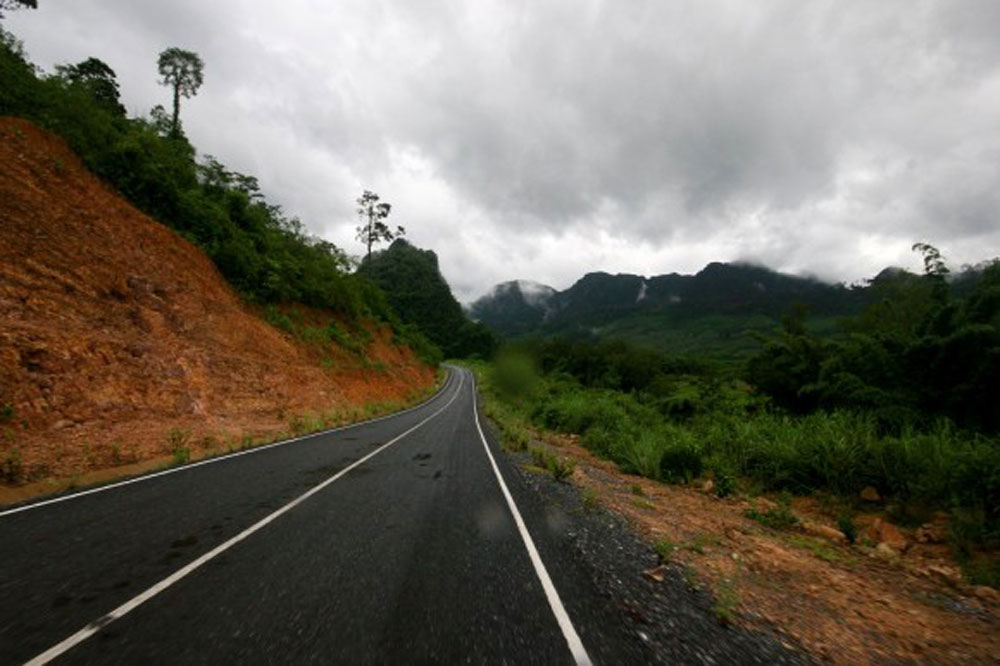
“I can do it! Nacho can do it!” I exclaimed.
“I don’t know, ” Sheena said, “I’m going to make a salad. Let’s try after lunch.” And so it was. Sheena made her salad and we sat down to a nice lunch while we watched through Nacho’s window as more and more people became brave enough to make the treacherous crossing. I wanted to get on it before my bravery waned, so we ate our fancy salads with balsamic vinegar and olive oil very quickly. All of the other cars had made the crossing now, leaving Nacho alone.

Just as we finished forking the final pieces of lettuce into our mouths, a young man on a farm tractor whizzed by. “Oh joy! A young man on a farm tractor!” I exclaimed.
I touched the corner of my mouth with a napkin the way British people do, and then I took my purple umbrella to the slide to watch the tractor boy work his magic. Oh the utility of people under hardship! The miracle of communism, just the way Marx envisioned! By the people for the people! The young man on the tractor started by proving his worthiness with a bit of showboatery. He worked the controls like a machinist, deftly scraping one or two tons of mud into the tracks that once served as the only passable route from our side to the other. Next, he pulled to the side of the road, turned the engine off, and sat there silently.
“What? Hey, why’d he stop? Sheena, do you know?” I walked over to the tractor and inspected the undercarriage. Was it broken? I took my shoes off and walked into the mud to see if the track was passable any more. It definitely wasn’t.
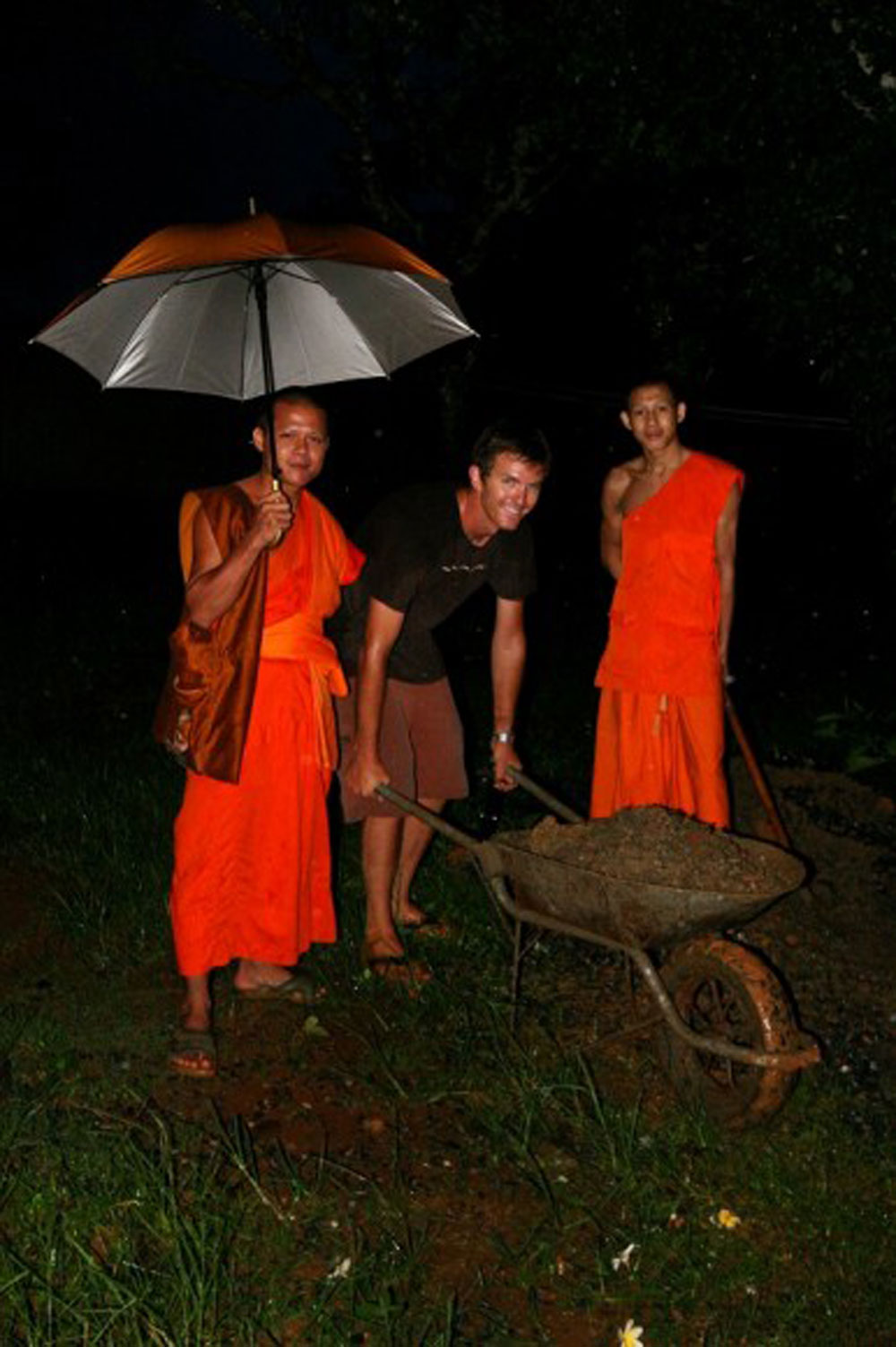
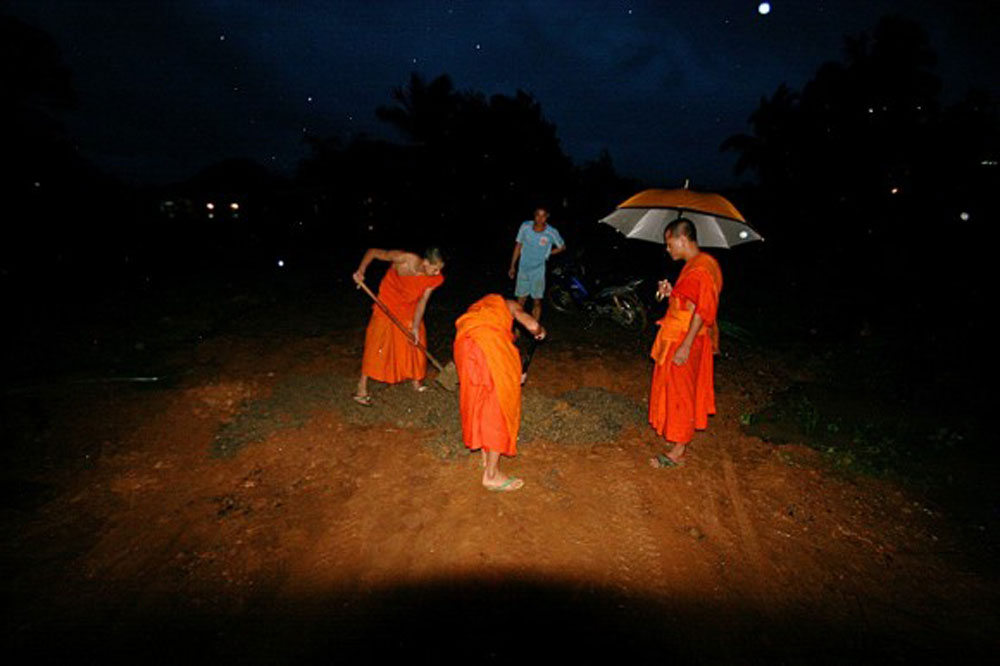
“Bah, I’m going to read a book.” And so we retreated to Nacho to read books. It would be thirty minutes before the young man on the tractor was content with the growing number of drivers that had collected on either side of the slide. He fired up the tractor and resumed his work while two of his associates worked their way up the line of cars. They approached Nacho, so I rolled down the window.
“Man oh man,” I commented, “that guy sure is making good progress.”
“Good money, good progress,” the tractor man’s associate said. “We’re collecting ten thousand Kip from every car.”
Marx would be saddened to know that communism in Laos had failed, even despite the Vietnam war in which the evil Americans were defeated, allowing communism to thrive. But dare I say that even Marx would be at least somewhat impressed by this young man’s astute planning and entrepreneurial prowess.
The rain continued to fall. It fell and it fell, and it covered the roadways. When it was shallow, we drove through. But when it was chest deep we had to find another way. Laos is serious about its rainy season.


Since arriving in Laos, we’ve been the proverbial thorn in the side of the country’s Buddhist monk population. Owing to southeast Asia’s distinct lack of camping opportunities, we’ve had to get pretty creative with our camp sites. Sometimes we simply camp in public parking lots (romantic), while in extremely rare cases (like twice), we find a nice beach overlook or rare dirt road into a forest where we can camp. While complaining to our friends in Thailand about this, one of them suggested that we camp within the grounds of Buddhist temples.
“Just ask the head monk if you can camp in their parking lot,” he had told us, “they always take care of travelers.”
And so we did. I must say that getting Sheena to agree to camp next to Buddhist temples is very hard, and I can’t understand why. It must be some deep ingrained malformation in the female genome that makes her feel uncomfortable whenever people know that we’re sleeping inside of our car, and it’s especially strong when those people are peace-loving Buddhist monks. But on occasion when we’re desperate enough, she will agree to it. This night was one of those nights.
After descending the mountains beyond the landslide site we arrived in a small village in heavy rain just as evening set in. We asked around at a couple of huts to see if we could park for the night, but were pointed in the direction of a temple. Sheena wailed her disapproval at the idea, but after convincing her that it was either this or on the side of the road, she grunted, crossed her arms, and silently agreed. I parked Nacho in the driveway of the temple, grabbed the paper from our dashboard that a Laotian man had written for us, which asks in Laos script if it’s okay for us to camp here for the night, and I headed into the monks’ house.
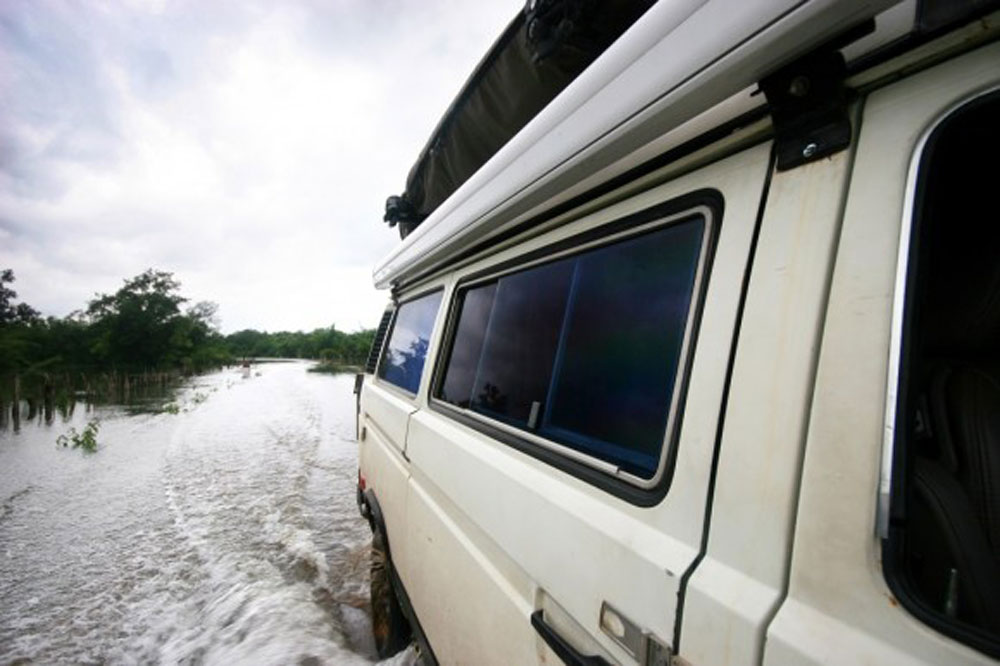
After five or six monks had read my note, each giggling a little bit and passing the note on, the paper landed in the hands of a monk who knew the English word “yes”. Riding high on the sweet endorphin wave that success brings, I floated back to Nacho, hopped into the front seat, and started lying to Sheena about how charming I had been when dealing with the monks. I threw it into drive and lurched forward. Almost immediately our front wheels disappeared straight into a hidden mud trench, and our bumper slammed to the ground.
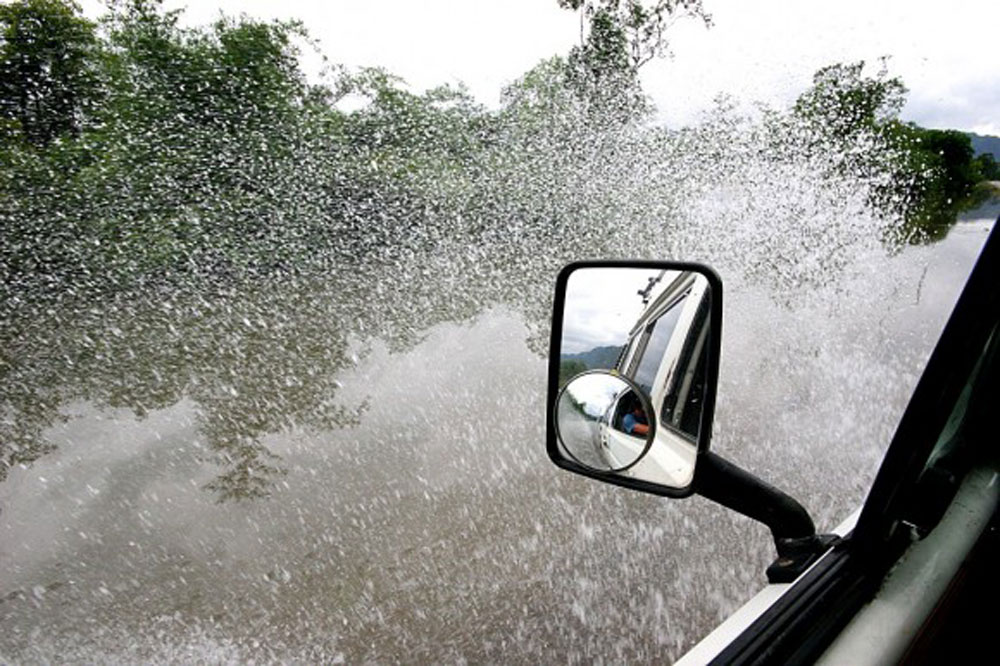
While no villagers had been visible before, our state of distress seemed to have been broadcast into every bamboo hut in the area, and within minutes we were surrounded by curious onlookers. I circled the van cursing our bad luck so close to our final destination. I decided the solution would involve our trusty jack, so I got that out and started jacking up one front corner. Soon the villagers swarmed the van, each making suggestions to me in Lao, which I didn’t understand. I jacked, villagers dug mud and collected pieces of wood and rock, and soon Nacho’s front wheels were supported by terra firma. I fired up the engine, and to the choir of incomprehensible shouting, I drove forward.
Now Nacho’s wheels straddled the trench, and I figured it best to use my bridging ladders to create a bridge for the rear wheels. I began to get out of the door.
“Ooga bing dang booga!” The villagers shouted, signaling that I should gun it and stop being a pansy.
“But I should use my bridging ladders, no?” I suggested.
“Dang ooga bing dang booga!” they shouted, again signaling for me to stop being such a sally girl. Did they know something I didn’t? I looked at the holes I’d just escaped from and they looked deep like bomb blast craters. The villagers pointed to the holes, told me to sack up, and signaled for me to gun it.
So I gunned it. The first thing I felt was slow forward motion, and then I felt the ground give way under the van, and then the rear bumper landing solidly on the ground. Yep, should have used the bridging ladders. Monks joined the entourage and we again jacked, dug, and shoved trash under tires. I gunned it, nothing happened, the entire village pushed, I gunned it again, and still nothing happened. Finally a 4×4 truck found its way to the temple, we attached a tow rope, the truck burned its tires, I burned my clutch, but nothing. Finally, adding village pushing power to the towing force, we managed to get loose and drive into the temple grounds. We profusely thanked the villagers, saw them off, and parked for the night.
As we parked, the monks streamed out of the temple, picked up two wheelbarrows and an array of shovels, and went to work filling the bomb blast craters in their driveway. I grabbed my shovel and joined the effort. Buddhist monks are happy people, always smiling, but I have to believe that they must have thought that we were a huge pain in the ass. We finished filling the holes, the monks smiled at us, and they retreated.
Later on, one monk returned to the van carrying a cell phone. I came out of the van and he handed me the phone.
“Hello?”
“Yes hello, I am the monk’s friend. He wanted me to ask you what you want them to make you for dinner.”
“Oh, please, nothing. They’ve done enough. We’re just passing through and have our own food.”
“Do you need bedding? A place to sleep? They can do anything for you.”
I told the man that we were totally self sufficient, and that we appreciated the help they’d already given us. All the while I wondered how, after having been such a pain in the ass, they could extend such unwarranted kindness towards us.
In the morning there was a knock on our door, and outside we could hear someone yelling “Hello! Hello!” I opened the door to find a monk carrying a warm bowl of tapioca and corn porridge. They’d made us breakfast! He asked if we wanted any coffee, made sure we had everything we needed, and then we watched him walk through the steady rain, back to his room.


